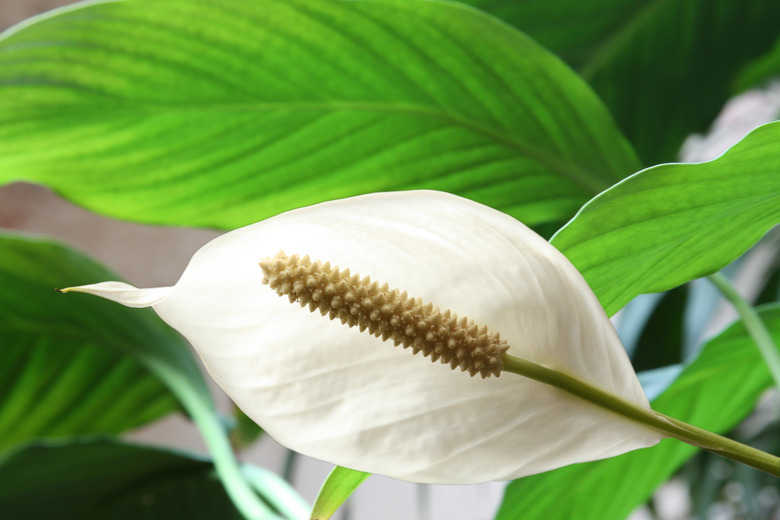How To Get Rid Of Peace Lily Bugs
Not lilies at all, but herbaceous perennials native to the jungles of Central and South America, peace lilies (Spathiphyllum spp.) grow outdoors in U.S. Department of Agriculture plant hardiness zones 11 through 12. Everywhere else, they grow as indoor plants and do double duty by removing air pollutants. When bugs occasionally invade peace lilies, getting rid of them is fairly easy.
Honeydew-Producing Bugs
Honeydew-Producing Bugs
A female aphid never dines alone. She's born pregnant and gives birth to between three and six pregnant daughters a day. Each of them starts giving birth a few days later. Colonies of the pear-shaped green bugs crowd tender new growth and the backs of leaves.
Mealybugs cluster on the backs of leaves, along leaf veins and where the leaves emerge from the soil. They resemble bits of fluffy cotton. Like aphids, they drain sap with hollow, hypodermic-sharp mouths.
Both bugs excrete undigested sap as sticky honeydew. It often attracts ants and sooty mold spores that germinate into greasy black fungus.
Aphid and Mealybug Control
Aphid and Mealybug Control
To eradicate early aphid or mealybug infestations, wrap the pot in a plastic bag, tie it shut, set the plant in the shower or sink and rinse it thoroughly with a strong spray of water.
Manage a few mealybugs by wiping the plant down with a cotton swab dipped in rubbing alcohol.
Smother large aphid or mealybug colonies with organic, ready-to-use insecticidal soap. Spray until the soap drips from all the plant's surfaces, including the backs of the leaves. Reapply it weekly, or at the manufacturer's recommended rate, until the bugs are gone.
Protect yourself from drifting soap spray with a long-sleeved shirt, long trousers, waterproof gloves, safety goggles and a respiratory mask.
Spider Mites
Spider Mites
Eight-legged spider mites feed on sap without producing honeydew. Stippled, curled leaves shrouded in fine webbing signal a spider mite attack.
Verify an infestation by shaking the peace lily over a sheet of white paper. The spider mites resemble dust particles scurrying over the white background.
Spraying with water or insecticidal soap spray is effective against aphids and mealybugs. It also eradicate spider mites.
Fungus Gnats
Fungus Gnats
Tiny black insects flying erratically around a peace lily are fungus gnats. Recognizable from their long antennae and legs, they hatch from eggs deposited in the potting soil. Although harmless as adults, they may feed on roots and leaves as larvae.
Moist, peat-based moss growing medium attracts the egg-laying gnats. Letting the top 2 inches of the medium dry between watering sessions discourages them and reduces egg and larvae survival rates.
If drier medium doesn't solve the problem, kill the adults with ready-to-use pyrethrin spray. Drench the entire plant and the gnats with the spray, and repeat every two days, or at the label's suggested interval, until they're gone.
To avoid skin or eye irritation, wear protective clothing and eyewear while spraying, and wash exposed skin thoroughly with soap and water afterwards.
Use commercially available Steinernema feltiae nematodes to parasitize gnat larvae by releasing bacteria that dissolve their internal organs. The pests begin dying within four days. Simply scatter the nematodes over the surface of the potting soil, water them in and keep the potting soil moist while they work.
References
- Missouri Botanical Garden: Spathiphyllum (Group)
- American Society for the Prevention of Cruelty to Animals: Peace Lily
- Missouri Botanical Garden: Aphids — Indoors
- Missouri Botanical Garden: Mealybugs — Indoors
- Missouri Botanical Garden: Spider Mites — Indoors
- Colorado State University Extension: Fungus Gnats as Houseplant and Indoor Pests
